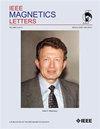MESO Neuron: A Low-Power and Ultrafast Spin Neuron for Neuromorphic Computing
IF 1.1
4区 物理与天体物理
Q4 ENGINEERING, ELECTRICAL & ELECTRONIC
引用次数: 0
Abstract
In this letter, a low-power and ultrafast spin neuron for mimicking biological neurons based on magneto-electric spin-orbit (MESO) neurons is presented. First, the physical model of a MESO neuron based on the Landau–Lifshitz–Gilbert (LLG) equation at room temperature is built for investigating the characteristics. By utilizing these characteristics of the MESO device, a current pulse is used to induce the stochastic switching behaviors. We successfully mimic the behavior of the biological neuron with single activation time down to 0.8 ns. Second, using model-derived device parameters, we further simulate a three-layer fully connected neural network using MESO neurons. Using the Mixed National Institute of Standards and Technology database handwritten pattern dataset, our system achieves a recognition accuracy of 98%. In addition, the influence of pulsewidth and amplitude on activation functions of MESO neurons is researched using HSPICE tools. The results show that as pulsewidth and amplitude are increasing, the power consumption and computing time increase while the energy consumption decreases. Specifically, the power consumption performance of a MESO neuron is about 10 µW and improved approximately three orders of magnitude compared to a 45 nm CMOS neuron.MESO神经元:一种用于神经形态计算的低功耗超快自旋神经元
在这封信中,提出了一种基于磁电自旋轨道(MESO)神经元的低功率超快自旋神经元,用于模拟生物神经元。首先,基于Landau–Lifshitz–Gilbert(LLG)方程,在室温下建立了MESO神经元的物理模型,以研究其特性。利用MESO器件的这些特性,使用电流脉冲来诱导随机开关行为。我们成功地模拟了生物神经元的行为,单次激活时间低至0.8纳秒。其次,利用模型推导的设备参数,我们进一步模拟了一个使用MESO神经元的三层全连接神经网络。使用国家标准与技术研究所混合数据库手写模式数据集,我们的系统实现了98%的识别准确率。此外,还利用HSPICE工具研究了脉冲宽度和振幅对MESO神经元激活功能的影响。结果表明,随着脉冲宽度和幅度的增加,功耗和计算时间增加,能耗降低。具体而言,MESO神经元的功耗性能约为10µW,与45nm CMOS神经元相比,功耗性能提高了约三个数量级。
本文章由计算机程序翻译,如有差异,请以英文原文为准。
求助全文
约1分钟内获得全文
求助全文
来源期刊

IEEE Magnetics Letters
PHYSICS, APPLIED-
CiteScore
2.40
自引率
0.00%
发文量
37
期刊介绍:
IEEE Magnetics Letters is a peer-reviewed, archival journal covering the physics and engineering of magnetism, magnetic materials, applied magnetics, design and application of magnetic devices, bio-magnetics, magneto-electronics, and spin electronics. IEEE Magnetics Letters publishes short, scholarly articles of substantial current interest.
IEEE Magnetics Letters is a hybrid Open Access (OA) journal. For a fee, authors have the option making their articles freely available to all, including non-subscribers. OA articles are identified as Open Access.
 求助内容:
求助内容: 应助结果提醒方式:
应助结果提醒方式:


